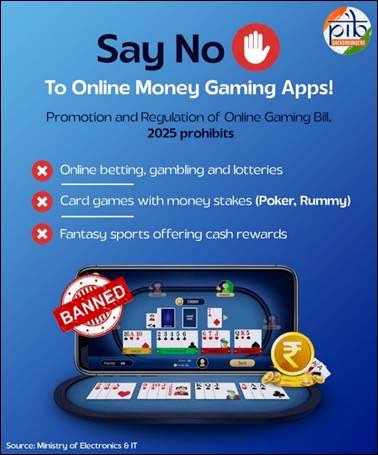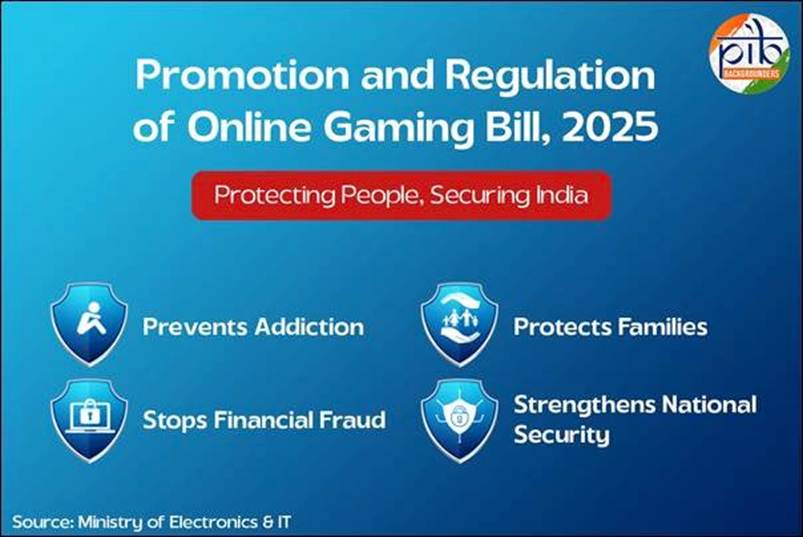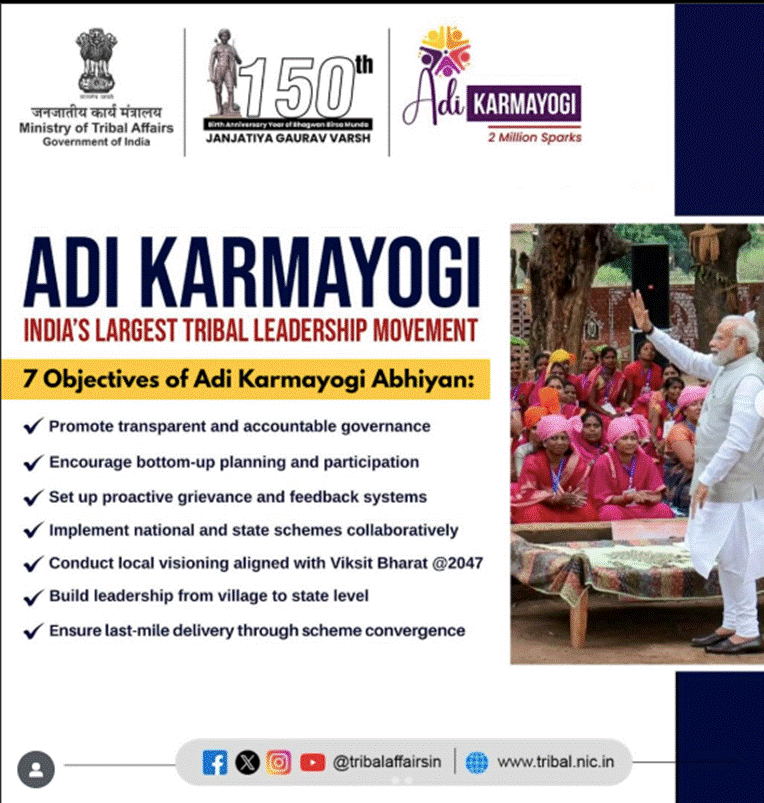Content
- Promotion and Regulation of Online Gaming Bill, 2025
- Adi Karmayogi Abhiyan (2025)
Promotion and Regulation of Online Gaming Bill, 2025
Context and Rationale
- Digital Economy Shift: Online gaming has emerged as one of the fastest-growing digital sectors in India (projected at $8.6 bn by 2027).
- Triple Dimension of Gaming:
- E-sports → constructive, competitive, skill-based.
- Online social games → casual, recreational, educational.
- Online money games → exploitative, involving gambling-like elements.
- Public Health Concerns: WHO classified gaming disorder in ICD-11, highlighting addiction, loss of control, and harmful persistence.
- Indian Scenario:
- 45 crore people adversely affected by online money games (Govt estimate).
- ₹20,000+ crore financial losses due to addiction-driven gaming.
- Reported rise in suicides linked to money-game debts.
- Legal Gap: Betting & gambling prohibited under state laws + Bharatiya Nyaya Sanhita (2023), but online gaming largely unregulated.
Relevance : GS 2(Social Issues , Governance)

Why the Bill Was Needed
- Addiction & Debt Trap: Young and middle-class families vulnerable.
- Mental Health & Suicides: Direct link with financial distress.
- Fraud & Money Laundering: Offshore gaming platforms used for laundering illegal money.
- National Security: Some platforms misused for terror financing & illegal messaging.
- Regulatory Vacuum: Lack of consistent central law created jurisdictional issues across states.
- Promotion of Healthy Alternatives: Needed a framework to promote esports & constructive digital creativity.

Key Features of the Bill
Applicability
- Extends to entire India + offshore platforms offering services within India.
Promotion and Recognition of E-sports
- Declared a legitimate competitive sport.
- Ministry of Youth Affairs & Sports to frame standards, tournaments, academies, tech hubs.
- Incentives for players & awareness campaigns to integrate esports into mainstream sports.
Promotion of Social & Educational Games
- Govt powers to recognise, certify, and promote age-appropriate, educational, cultural, or skill-oriented games.
- Creation of safe platforms to distribute such content.
Prohibition of Online Money Games
- Complete ban on games involving financial stakes (chance, skill, or hybrid).
- Ban extends to advertisement, promotion, and financial transactions.
- RBI & banks barred from processing payments related to such platforms.
- Power to block access under Section 69A of IT Act, 2000.
Establishment of an Online Gaming Authority
- Regulatory body for categorisation, registration, grievance redressal.
- Authority empowered to decide whether a game is skill/social or money game.
- Can issue guidelines, codes of practice, directions.
Offences and Penalties
- Offering/facilitating money games → up to 3 years jail + ₹1 crore fine.
- Advertising money games → up to 2 years jail + ₹50 lakh fine.
- Repeat offenders → harsher (5 years jail + ₹2 crore fine).
- Cognisable & non-bailable offences.
Corporate and Institutional Liability
- Companies + responsible officers liable.
- Independent/non-executive directors exempt if due diligence proven.
Investigation & Enforcement
- Central Government authorised to empower officers for search, seizure, arrests without warrant.
- Investigations under Bharatiya Nagarik Suraksha Sanhita, 2023.
Rule-Making Powers
- Central Govt empowered to frame rules for e-sports promotion, recognition of games, functioning of authority.
Linkages with Existing Legal Framework
- IT Act, 2000: Section 69A used to block >1,500 betting/gambling sites since 2022.
- IT Rules, 2021 (Amended 2023): Online intermediaries accountable; registration with Self-Regulatory Bodies (SRBs).
- Bharatiya Nyaya Sanhita, 2023: Sections 111–112 penalise unlawful betting, cyber fraud.
- IGST Act, 2017: Offshore platforms brought under taxation net.
- Consumer Protection Act, 2019: Bans misleading ads; CCPA action against celebrities promoting betting apps.
- Advisories: MIB (ads), MoE (guidelines for parents/teachers on safe gaming).
- Cybercrime Mechanisms: National Cyber Crime Reporting Portal + Helpline 1930.
Expected Benefits
Societal
- Protection of Families: Shields youth and middle class from addiction-driven debt.
- Safer Digital Space: Eliminates predatory platforms.
- Mental Health Safeguard: Prevents stress and suicides.
Economic
- Boost to Creative Economy: E-sports & educational gaming → jobs, exports, innovation.
- Global Competitiveness: India positioned as hub for safe gaming tech & esports.
Policy & Governance
- Closing Loopholes: Brings digital domain under same restrictions as physical gambling.
- Global Leadership: Model for responsible regulation balancing innovation & social protection.
Challenges in Implementation
- Extraterritorial Jurisdiction: Offshore betting servers may bypass restrictions using VPNs/crypto.
- Enforcement Capacity: Requires strong cyber-policing, tech monitoring.
- Balancing Innovation vs Regulation: Ensuring esports/social games don’t get caught in red tape.
- State vs Centre: Gaming traditionally a “State subject”; Centre legislating may face federal pushback.
- Addiction Beyond Money Games: Even non-money esports/social games can lead to overuse.
Strategic Significance
- Digital Sovereignty: Asserts India’s control over digital economy.
- Youth Empowerment: E-sports as a new career stream.
- National Security: Closes a channel for terror financing.
- Social Justice: Protects vulnerable groups (youth, lower & middle-income families).
Conclusion
- The Promotion and Regulation of Online Gaming Bill, 2025 is both protective and promotional.
- It bans exploitative online money games while nurturing safe, skill-based, and creative digital spaces.
- Represents India’s balanced digital policy model: innovation + responsibility.
- Strengthens India’s image as a global leader in responsible gaming regulation.
- Long-term success depends on strict enforcement, inter-agency coordination, and international cooperation against offshore betting networks.
Adi Karmayogi Abhiyan (2025)
Background & Context
- Tribal Demography: ~10.45 crore Scheduled Tribe population (2011 Census), spread across 550+ districts in 30 States/UTs, often living in remote areas with governance gaps.
- Persistent Issues: Last-mile delivery failures, lack of grassroots leadership, health challenges (e.g., sickle cell anaemia), and socio-economic exclusion.
- Policy Continuity: Builds on recent tribal initiatives – PM JANMAN (2023), Dharti Aaba Janjatiya Gram Utkarsh Abhiyan, Sickle Cell Anaemia Elimination Mission.
- Vision: Aligned with Janjatiya Gaurav Varsh (tribal pride year) and long-term Viksit Bharat@2047.
- Guiding Philosophy: Sewa (Service), Sankalp (Resolve), Samarpan (Dedication) – reinforcing PM’s inclusive development motto: “Sabka Saath, Sabka Vikas, Sabka Prayas, Sabka Vishwas.”
Relevance : GS 1(Society) , GS 2(Social Issues , Governance)

Objectives of the Abhiyan
- Responsive Governance: Institutionalise people-centric, accountable governance at village/community level.
- Capacity-Building through Governance Labs: Multi-departmental Process Labs from State → District → Block → Village, training master trainers and frontline workers.
- Vision-Building: Co-create “1 Lakh Tribal Villages – Vision 2030” with communities + officials, focusing on local action plans, investments, and scheme convergence.
- Leadership Development: Build a network of 20 lakh tribal change leaders (Karmayogis) across India to sustain reforms.
- Inclusive Participation: Engage youth, SHGs, Anganwadi/ASHA workers, PRI members, tribal elders, and professionals.
- Scheme Saturation: Ensure every eligible tribal household/village avails all government benefits.
Structural Design of the Programme
Institutional Mechanisms
- Adi Sewa Kendras:
- One-stop village-level centres for service delivery.
- Activities: Adi Sewa Samay (fortnightly service/mentoring), Seva Hour (weekly grievance redressal), Seva Day (monthly service delivery drives).
- Responsive Governance Groups: At District & Block levels to provide sustained mentorship and coordinate activities.
- Civil Society Partnerships: NGOs, CSOs, and Sahyogis as field facilitators/mentors.
Capacity-Building Model
- Governance Labs / Process Labs: Structured training hubs for master trainers.
- Curriculum Focus: Responsive governance, grievance redressal, participatory planning, social mobilisation, and convergence.
- Cascade Model: Master Trainers → Frontline Workers → Community Volunteers → Villagers.
Volunteer Ecosystem
- Adi Sahyogi: Professionals (teachers, doctors, skilled mentors).
- Adi Saathi: SHG leaders, NRLM members, PRI representatives, tribal youth, elders.
- Village Karmayogis: Trained grassroots leaders ensuring scheme delivery.
Core Components
- Adi Sewa Kendra: Anchor of participatory governance at village level.
- Governance Labs: Workshops to co-create local solutions, multi-departmental integration.
- Tribal Village Vision 2030: Participatory planning aligned with SDGs + national priorities.
- Community Leadership Training: Skill-building for youth, women, and traditional leaders.
- Wall Paintings & Participatory Exercises: Tools for community mobilisation and vision-building.
- Real-Time Documentation: Local innovations, feedback, success stories → fed upward to district/state for policy refinement.
Expected Outcomes
Governance
- Institutionalised grassroots leadership model for tribals.
- Enhanced responsiveness and accountability of government at local level.
- Stronger last-mile delivery of schemes (health, education, livelihoods).
Community Development
- Empowered cadre of 20 lakh tribal change leaders by 2030.
- Creation of Tribal Village Action Plans with convergence of multiple schemes.
- Reduction in governance gap between tribal and non-tribal areas.
Socio-Economic
- Greater participation of tribals in decision-making.
- Increased digital & administrative literacy among tribal youth/women.
- Better utilisation of government funds and schemes.
National Vision
- Tribal empowerment as central to Viksit Bharat@2047.
- Model for community-led development that balances tradition with modern governance.
Linkages with Other Programmes
- PM JANMAN (Pradhan Mantri Janjati Adivasi Nyaya Maha Abhiyan) – focused on PVTG development.
- National Sickle Cell Anaemia Elimination Mission (2023–2047) – addresses key health issue.
- Janjatiya Gram Utkarsh Abhiyan – improving tribal villages’ socio-economic indicators.
- NRLM & SHG ecosystem – women’s empowerment.
Challenges in Implementation
- Geographical Accessibility: Remote tribal areas with poor connectivity.
- Capacity Constraints: Need sustained training to avoid leadership burnout.
- Cultural Sensitivity: Risk of imposing top-down models that may clash with tribal traditions.
- Sustainability: Volunteer motivation and continuous funding for Sewa Kendras.
- Inter-departmental Convergence: Requires effective coordination across ministries/departments.
- Monitoring & Evaluation: Need robust real-time systems to track progress in 1 lakh villages.
Strategic Significance
- Governance Innovation: First attempt at systematised grassroots leadership training at national scale.
- Empowerment of Marginalised: Institutionalises tribal voices in development planning.
- Responsive Governance Model: Could be replicated for other vulnerable communities (Dalits, minorities).
- Nation-Building: Ensures tribals are active partners in India@2047 journey, not passive beneficiaries.
Conclusion
- Adi Karmayogi Abhiyan (2025) is not merely a welfare programme but a governance transformation mission.
- Moves from “delivery of schemes to tribals” → “development with tribals”.
- By building a cadre of 20 lakh trained tribal leaders, it creates institutional capacity within communities.
- If executed effectively, it will:
- Reduce exclusion,
- Strengthen democracy at the grassroots, and
- Position India as a global leader in participatory tribal governance models.



